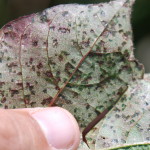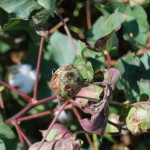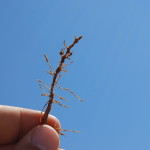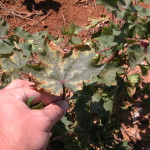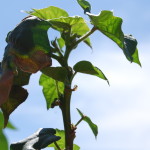by Jason Woodward, Extension Plant Pathologist
Cotton around the state is at various growth stages ranging from cutout in the south to pinhead square in parts of the High Plains. Furthermore, a high degree of variability can be seen across an area or within a county. Unseasonably wet conditions in addition to relatively cool temperatures experienced early in the growing season are responsible for some of the variability being exhibited by the crop. While temperatures in the High Plains have increased, remnants of monsoonal moisture are evident with relative humidity levels being well above average. Such conditions are conducive for the development of both foliar and soilborne diseases. Observations of leaf spots caused by Alternaria spp., Cercospora gossypina or Stemphylium solani have been reported from southern areas of the state. Warmer temperatures should temper further development of leaf spot and limit any yield loss. Numerous samples of Bacterial blight, caused by Xanthomonas campestris pv. malvacearum, have been received from around the state. Cotton plants are susceptible to infection by the bacterium during all stages of development. Stand losses and reduced vigor can be experienced when infections occur during the seedling stage. More characteristic symptoms include small, dark green, water-soaked spots that are first visible on the underside of leaves. These lesions, which have an angular appearance and are delimited by the veins, later become present on the upper leaf surface (Fig. 1).
As the disease progresses, a second leaf symptom, referred to as Black arm, can be observed along main veins extending towards petioles and vegetative branches. As individual lesions coalesce and become necrotic, infected leaves will defoliate prematurely. Water-soaked lesions can develop on infected bolls (Fig. 2). These infections often result in a boll rot, which may affect color grades. There are no chemical management options available for Bacterial blight. The disease can currently be managed through the use of resistant varieties.
As a result of good soil moisture conditions, the damage potential for root-knot (Meloidogyne incognita) and reniform (Rotylenchulus reniformis) nematodes is rather high this year. Symptoms associated with nematodes include stunting, poor vigor, yellowing of leaves, and wilting. Such symptoms may be confused with nutrient deficiencies. Root-knot nematode problems can be diagnosed by the characteristic galls that form on the root of infected plants (Fig. 3). Diagnosis of the reniform nematode is more difficult, often requiring field sampling and laboratory confirmation. The amount of yield loss experienced is strongly correlated with nematode populations in the soil. Nematode damage is often enhanced when plants are experiencing other stress conditions.
Symptoms of Verticillium wilt and Fusarium wilt have also been observed over the past several weeks. Similarities between these two diseases often complicate diagnosis; however, subtle differences in the appearance of symptoms can be used to distinguish the two. Expression of Verticillium wilt, caused by Verticillium dahliae, is a result of systemic infections that lead to the vascular system of the plant becoming obstructed by the fungus. This is characterized by dark, necrotic flecks in the vascular tissue. More pronounced wilt symptoms are be observed during boll fill (Fig. 3), as the plant cannot adequately transport water and nutrients from the roots. Plants will have a mosaic appearance, and premature defoliation may occur. Significant reductions in lint yield and fiber quality can result from severe infections. Disease severity is closely connected the population density of the fungus in the soil. Assays can also be conducted to determine populations of the fungus in the soil.
Fusarium wilt is caused by the soilborne fungus, Fusarium oxysporum f. sp. vasinfectum. This disease is becoming increasingly important throughout cotton production regions of the Southern High Plains. Typical symptoms of Fusarium wilt include chlorosis (or yellowing) on the margin of leaves (Fig. 4). Inspection of the vascular system will reveal in discoloration of infected plants. If plants are infected early in the season, and adverse conditions are experienced, seedling mortality can occur. This may potentially be confused with seedling disease. In general, fields with a history of Fusarium wilt are also infested with the root-knot nematode. Attention should be paid to these fields, as Fusarium wilt could develop more rapidly as nematode populations increase. Occasionally, these diseases can occur in the same field, and may complicate which variety(s) should be planted in subsequent years. If you have any questions regarding these or any other cotton diseases contact Jason Woodward, Extension Plant Pathologist located in Lubbock, at jewoodward@ag.tamu.edu or 806-632-0762
- Figure 1
- Figure 2
- Figure 3
- Figure 4
- Figure 5

Associate Professor and Extension Plant Pathologist
Dept. of Plant Pathology and Microbiology
Texas A&M Agrilife Research
Lubbock, TX
806-746-6101
jewoodward@ag.tamu.edu
